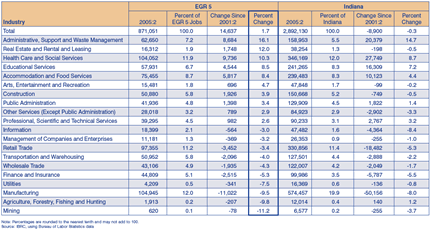Regional Perspective: Economic Growth Region 5
Over 1.7 million people call Economic Growth Region (EGR) 5 home, making it the most populated region in Indiana. Located in the heart of Indiana, the nine-county region includes Boone, Hamilton, Hancock, Hendricks, Johnson, Madison, Marion, Morgan and Shelby counties. Even if we were to remove the Indianapolis consolidated area (which, as the state's largest city, makes up more than 46 percent of the region's population) from the count, EGR 5 would remain the most-populated EGR in the state.
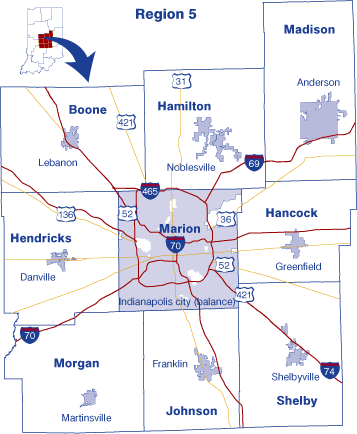
Region 5 saw an increase in population of nearly 106,000 people between July 2000 and 2004. At a more local level, only Madison County has seen a decrease in population, with a loss of nearly 2,900 people. Shelby County had the slightest gain (156 people), while Hamilton County saw the largest increase (more than 55,000 people). The population breakdown by county is shown in Figure 1.
Figure 1: EGR 5 Population Distribution
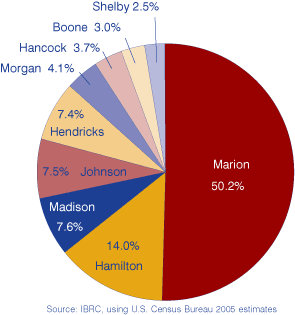
Jobs
Jobs are slightly more diversified across industry sectors in Region 5 than at the state level. Manufacturing, health care and social services, and retail trade supply 43.3 percent of all jobs statewide, while that number drops to 35.2 percent at the regional level. This means more jobs are divided among other industries in the region. While manufacturing employs the highest percentage of people both in the region and the state, only 12 percent of all regional jobs are in the manufacturing industry, while the remainder of Indiana sends 23.2 percent of all jobs into manufacturing.
If current trends continue, the health care and social services industry could easily surpass the number of jobs held in the manufacturing industry. From 2001:2 to 2005:2, manufacturing saw a decrease of more than 11,000 jobs in the region. Meanwhile, health care and social services added over 9,700 jobs in that same amount of time (see Table 1). The likelihood that these numbers will keep growing in opposite directions seems fairly certain, at least in the short-term. Added to the most-likely list of manufacturing closings (and not included in the 11,000 job loss number) is the Delphi plant in Anderson. If this plant closes as expected, Madison County and the surrounding area are expected to lose nearly 1,000 jobs. (1)
Table 1: Change in Jobs in EGR 5 and Indiana, 2001:2 to 2005:2
Wages
Region 5 has fared better than the state in terms of average weekly wages paid in 2005:2. EGR 5 paid higher weekly wages than the state average across every major industry sector (see Figure 2). The largest difference in pay was in the management of companies and enterprises, where EGR 5 paid $213 more on average per week than the entire state, more than $11,000 over the year. Both Indiana and the region have increased wages since 2001:2, but Region 5 increased at a faster rate in the majority of the industry sectors, outpacing the rest of the state.
Figure 2: Average Weekly Wages, 2005:2
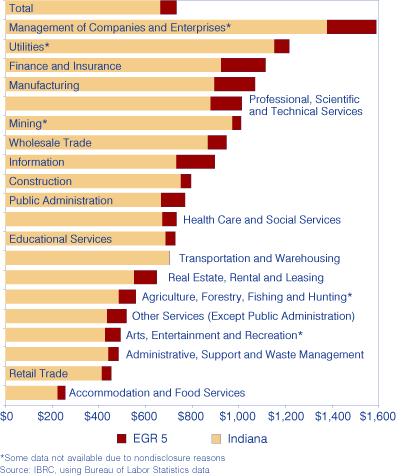
Commuting
Of the 815,115 people that work in EGR 5, 94.2 percent also live in the region. At the local level, Marion County unsurprisingly surpassed all other counties in the region in terms of the number of people who both live and work in the county. Over 368,000 workers fell into this category in Marion County, or eight-and-a-half times more than second place Hamilton County (43,356 workers). These same two counties contributed the highest number of workers to fellow EGR counties; Hamilton County sent out about 46,600 workers into the other eight counties, while Marion County sent out over 48,400 workers within the EGR. At the other end of the spectrum was EGR 5's least populated county: Shelby County didn't participate as much to intra-regional commuting, sending and receiving the fewest number of workers within the region. Figure 3 shows Region 5 commuting patterns.
Figure 3: EGR 5 Commuting Patterns, 2000
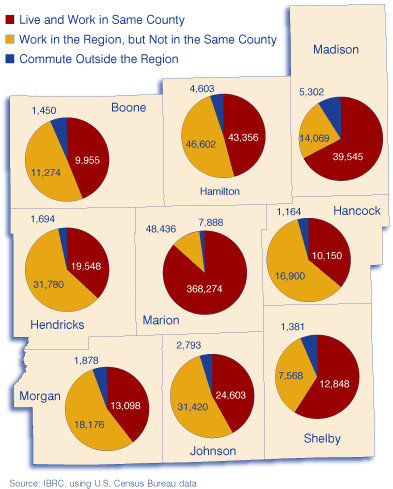
Conclusion
Region 5 seems to be more resilient than the rest of Indiana. While the state lost jobs, EGR 5 managed to add jobs while paying its workers more at the same time. As such, January unemployment rates in the region have stayed below both the state and the nation by at least 0.4 percentage points since 1990.
Notes
- Ted Evanoff, Raygan Swan and Erika D. Smith. “Anderson Now Faces Body Blow from Delphi,” Indianapolis Star, April 2, 2006.
Molly
Marlatt, Research Associate
Indiana Business Research Center,
Kelley School of Business, Indiana University

